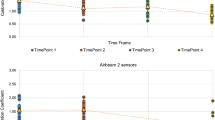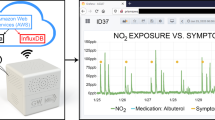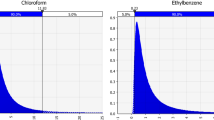Abstract
Despite long-standing awareness of adverse health effects associated with chronic human exposure to formaldehyde, this hazardous air pollutant remains a challenge to measure in indoor environments. Traditional analytical techniques evaluate formaldehyde concentrations over several hours to several days in a single location in a residence, making it difficult to characterize daily temporal and spatial variation in human exposure to formaldehyde. There is a need for portable, easy-to-use devices that are specific and sensitive to gas-phase formaldehyde over short sampling periods so that dynamic processes governing formaldehyde fate, transport, and potential remediation in indoor environments may be studied more effectively. A recently developed device couples a chemical sensor element with spectrophotometric analysis for detection and quantification of part per billion (ppbv) gas-phase formaldehyde concentrations. This study established the ability of the coupled sensor-spectrophotometric device (CSSD) to report formaldehyde concentrations accurately and continuously on a 30-min sampling cycle at low ppbv concentrations previously untested for this device in a laboratory setting. Determination of the method detection limit (MDL), based on 40 samples each at test concentrations of 5 and 10 ppbv, was found to be 1.9 and 2.0 ppbv, respectively. Performance of the CSSD was compared with the dinitrophenylhydrazine (DNPH) derivatization method for formaldehyde concentrations ranging from 5–50 ppbv, and a linear relationship with a coefficient of determination of 0.983 was found between these two analytical techniques. The CSSD was also used to monitor indoor formaldehyde concentrations in two manufactured homes. During this time, formaldehyde concentrations varied from below detection limit to 65 ppbv and were above the US National Institute for Occupational Safety and Health (NIOSH) recommended exposure limit (REL) of 16 ppbv, which is also the exposure limit value now adopted by the US Federal Emergency Management Agency (FEMA) to procure manufactured housing, 80% and 100% of the time, respectively.
This is a preview of subscription content, access via your institution
Access options
Subscribe to this journal
Receive 6 print issues and online access
$259.00 per year
only $43.17 per issue
Buy this article
- Purchase on Springer Link
- Instant access to full article PDF
Prices may be subject to local taxes which are calculated during checkout



Similar content being viewed by others
References
O’Brien PJ, Siraki AG, Shangari N . Aldehyde sources, metabolism, molecular toxicity mechanisms, and possible effects on human health. Crit Rev Toxicol 2005; 35: 609–662.
US Environmental Protection Agency. IRIS toxicological review of formaldehyde (inhalation) (External Review Draft). EPA/635/R-10/002A. Environmental Protection Agency: Washington, DC, USA. 2010.
International Agency for Research on Cancer. Formaldehyde. In: Formaldehyde, 2-butoxyethanol and 1-tert- butoxypropan-2-ol. IARC Monogr Eval Carcinog Risk Hum 2006; 88: 39–325.
National Toxicology Program Report on Carcinogens, Twelfth Edition. Research Triangle Park, NC: U.S. Department of Health and Human Services, Public Health Service, National Toxicology Program 2011.
Offermann FJ Ventilation and indoor air quality in new homes. California Air Resources Board and California Energy Commission, PIER Energy‐Related Environmental Research Program. Collaborative Report. CEC‐500‐2009‐085 2009.
FEMA. FEMA response to formaldehyde in trailers (redacted). Department of Homeland Security, Office of Inspector General: Washington, DC, USA. 2008.
World Health Organization WHO guidelines for indoor air quality: selected pollutants. Bonn Office: The WHO Centre for Environment and Health 2010.
World Health Organization Air quality guidelines for Europe. WHO Regional Publications, European Series Copenhagen: World Health Organization Regional Office for Europe 1987.
OEHHA CA Methodologies for derivation, listing of available values, and adjustments to allow for early life stage exposures. Technical Support Document for Cancer Potency Factors. Appendix A: Hot Spots Unit Risk and Cancer Potency Values. Sacramento, CA: California Environmental Protection Agency, Office of Environmental Health Hazard Assessment, Air Toxicology and Epidemiology Branch 2009.
Hak C, Pundt I, Trick S, Kern C, Platt U, Dommen J et al. Intercomparison of four different in-situ techniques for ambient formaldehyde measurements in urban air. Atmos Chem Phys 2005; 5: 2881–2900.
Wisthaler A, Apel EC, Bossmeyer J, Hansel A, Junkermann W, Koppmann R et al. Technical note: intercomparison of formaldehyde measurements at the atmosphere simulation chamber SAPHIR. Atmos Chem Phys 2008; 8: 2189–2200.
Salthammer T, Mentese S . Comparison of analytical techniques for the determination of aldehydes in test chambers. Chemosphere 2008; 73: 1351–1356.
Barro R, Regueriro J, Llompart M, Garcia-Jares C . Analysis of industrial contaminants in indoor air: part 1. Volatile organic compounds, carbonyl compounds, polycyclic aromatic hydrocarbons and polychlorinated biphenyls. J Chromatogr A 2009; 1216: 540–566.
Salthammer T, Mentese S, Marutzky R . Formaldehyde in the indoor environment. Chem Rev 2010; 110: 2536–2572.
US Environmental Protection Agency Method TO-11A. Cincinnati, OH: US EPA 1999.
ASTM. Standard test method for determination of formaldehyde and other carbonyls compounds in air (active sampler methodology). ASTM International: West Conshohocken, PA, USA. 1997.
Martos PA, Pawliszyn J . Sampling and determination of formaldehyde using solid-phase microextraction with on-fiber derivatization. Anal Chem 1998; 70: 2311–2320.
Junkermann W, Burger JM . A new portable instrument for continuous measurement of formaldehyde in ambient air. J Atmos Oceanic Tech 2006; 23: 38–45.
Won D, Nong G, Yang W, Scheibinger H Characterizing commercially available formaldehyde sensors. In: Proceedings of Indoor Air 2011 2011; a126.
Xiao GG, Zhang Z, Weber J, Ding H, McIntosh H, Desrosiers D et alTrace amount formaldehyde gas detection for indoor air quality monitors. NRCC-54484 2011.
Maruo YY, Nakamura J, Uchiyama M . Development of formaldehyde sensing element using porous glass impregnated with β-diketone. Talanta 2008; 74: 1141–1147.
Maruo YY, Yamada T, Nakamura J, Izumi K, Uchiyama M . Formaldehyde measurements in residential indoor air using a developed sensor element in the Kanto area of Japan. Indoor Air 2010; 20: 486–493.
Tokumitsu S, Izumi K, Utiyama M, Maruo Y Interferences of various gases on porous glass-based formaldehyde sensors. In Control, Automation and Systems, 2008. ICCAS 2008. International Conference on (pp. 974-977). IEEE.
Gordon S, Callahan P, Nishioka M, Brinkman M, OÕRourke M, Lebowitz M et al. Residential environmental measurements in the National Human Exposure Assessment Survey (NHEXAS) pilot study in Arizona: preliminary results for pesticides and VOCs. J Expo Anal Environ Epidemiol 1999; 9: 456–470.
Weisel CP, Zhang J, Turpin BJ, Morandi MT, Colome S, Stock TH et alRelationship of Indoor, Outdoor, and Personal Air (RIOPA): Part I. collection methods and descriptive analyses. HEI Report No. 130 (Pt. 1) NUATRC Report No. 7. Boston, MA: Health Effects Institute, Houston, TX: National Urban Air Toxics Research Center 2005.
National Research Council. Review of the Environmental Protection Agency’s draft IRIS assessment of formaldehyde, Board on Environmental Studies and Toxicology. The National Academies Press: Washington, DC, USA. 2011.
Hodgson AT, Rudd AF, Beal D, Chandra S . Volatile organic compounds concentrations and emission rates in new manufactured and site-built houses. Indoor Air 2000; 10: 178–192.
Ward PM, Peters PA . Self-help housing and informal homesteading in peri-urban America: settlement identification using digital imagery and GIS. Habitat Int 2007; 31: 205–218.
Huh MH . Equivalence testing as an alternative to significance testing. J Korean Stat Soc 1994; 23: 199–206.
Barker LE, Luman ET, McCauley MM, Chu SY . Assessing equivalence: an alternative to the use of difference tests for measuring disparities in vaccination coverage. Amer J Epidemiol 2002; 156: 1056–1061.
Hun DE, Shrestha S, Jackson MC Optimization of ventilation energy demands and indoor air quality in airtight ZEBR Alliance homes, Final Report, U.S. Department of Energy 2013.
CA OEHHA. Acute, 8-hour, and chronic recommended exposure limits (chRELs). Technical Support Document for Noncancer RELs, Appendix D1. California Environmental Protection Agency, Office of Environmental Health Hazard Assessment, Air Toxicology and Epidemiology Branch: Sacramento, CA, USA. 2008, 128–169.
Mandin C, Bonvallot N, Kirchner S, Keirsbulck M, Alary R, Cabanes P et al. Development of French indoor air quality guidelines. Clean 2009; 37: 494–499.
NIOSH NIOSH Pocket Guide to Hazardous Chemicals, National Institute of Occupational Safety and Health 2010 Available from http://www.cdc.gov/niosh/npg/npgd0293.html.
HK IAQ MG A guide on indoor air quality certification scheme for office and public places. Government of Hong Kong Special Administrative Region, Indoor Air Quality Management Group 2003.
California Environmental Protection Agency Air Resources Board. Formaldehyde in the home: indoor air quality guideline. 2004; 1: 1–16.
Health Canada. Residential indoor air quality guideline: formaldehyde. Health Canada 2006, 4120 ISBN: 0-662-42661-4.
Acknowledgements
We thank Matrix Analytical Laboratories for their assistance in completing analysis of DNPH samples and the Indoor Air Quality Group at the National Institute of Standards and Technology for loan of equipment. EMC and this work were supported by US Environmental Protection Agency STAR Fellowship program and the American Society of Heating, Refrigerating, and Air-conditioning Engineers Grant-In-Aid. We would also like to thank the community members of Cottonwood Creek for the opportunity to carry out sampling in the field.
Author information
Authors and Affiliations
Corresponding author
Ethics declarations
Competing interests
The authors declare no conflict of interest.
Rights and permissions
About this article
Cite this article
Carter, E., Jackson, M., Katz, L. et al. A coupled sensor-spectrophotometric device for continuous measurement of formaldehyde in indoor environments. J Expo Sci Environ Epidemiol 24, 305–310 (2014). https://doi.org/10.1038/jes.2013.61
Received:
Accepted:
Published:
Issue Date:
DOI: https://doi.org/10.1038/jes.2013.61
Keywords
This article is cited by
-
Ti3C2Tx/SnO2 P–N heterostructure construction boosts room-temperature detecting formaldehyde
Rare Metals (2024)
-
Continuous real-time monitoring of formaldehyde over 5 weeks in two French primary schools: identification of the relevant time resolution and the most appropriate ventilation scenario
Air Quality, Atmosphere & Health (2023)



